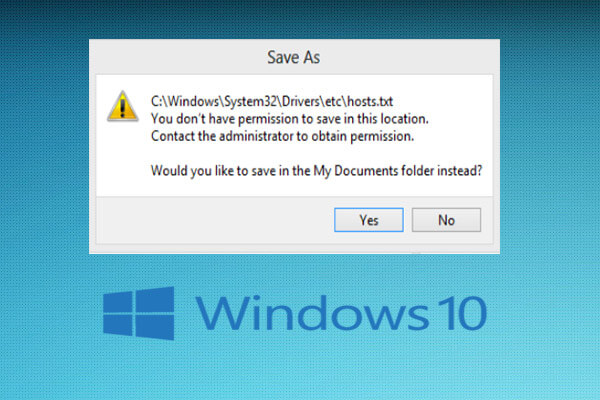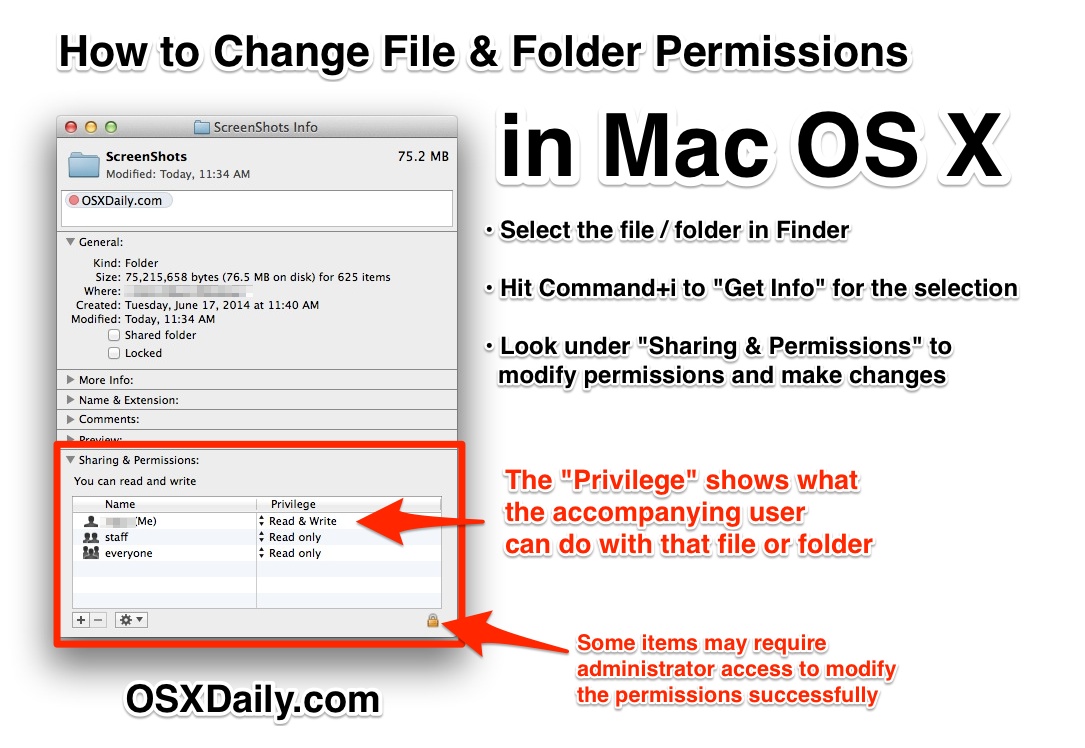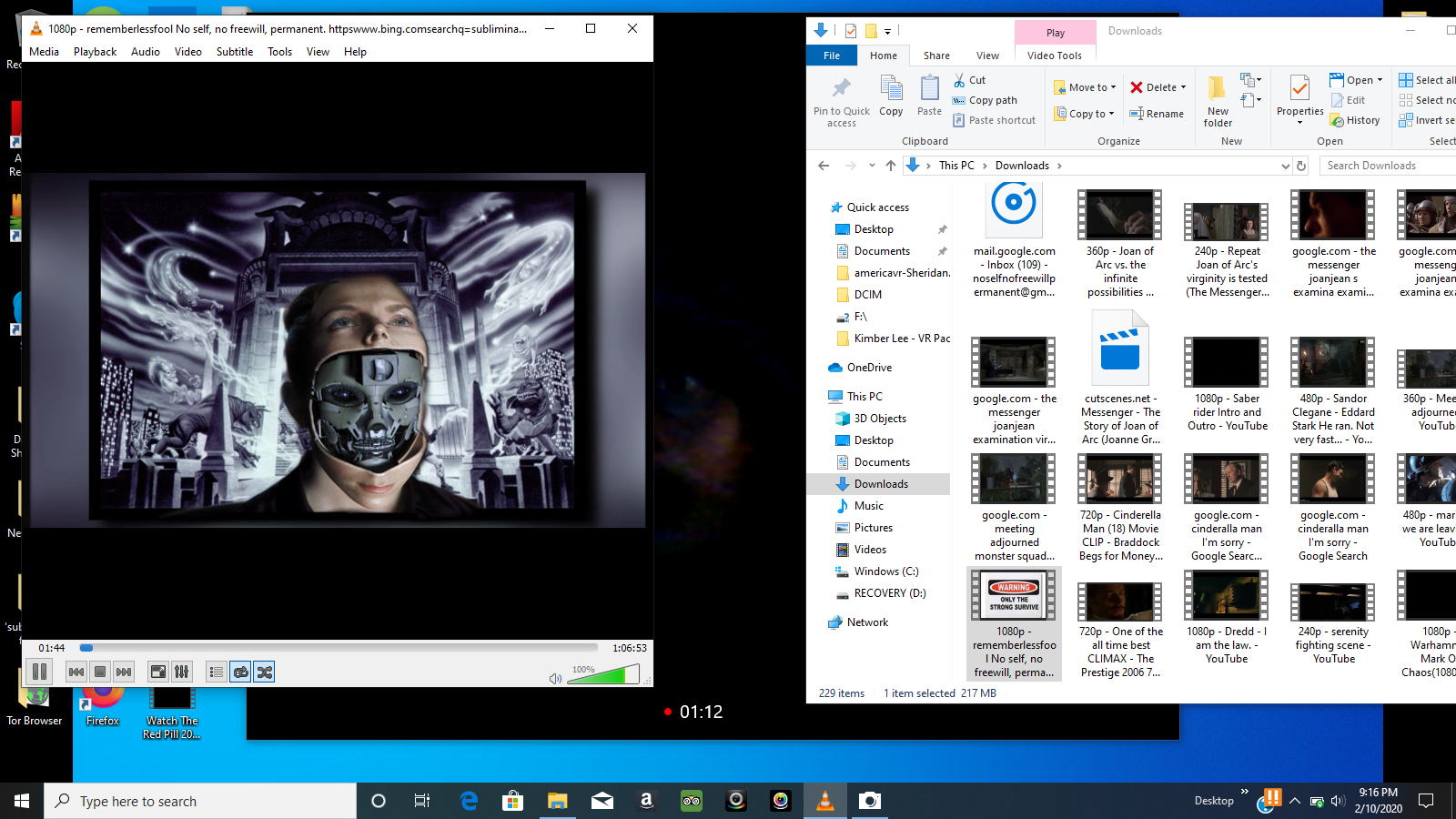Noelle Oliveira says her Mac isn’t letting her save files from several different programs. She consistently receives the error (with various filenames and folder locations):
“filename” couldn’t be moved because you don’t have permission to access “folder”.
macOS says she needs to change permissions on Desktop, but I’d wager most Mac users haven’t had to wrangle with this. Permissions are a Unix-level property attached to files (including apps) and folder that control the rights a given user or system agent has to read, write, execute, or act in other ways upon a file or folder.
Sets the directory and all sub directory permissions to 777 (all) permissions on Unix systems like OS X. I use it all the time as ALEXA SxS mags have their own permissions when they come off camera. In a larger network environment, consult your IT before doing this - you would likely set it to your user permission as opposed to EVERYONE.
- As we known, each file and folder contains the permission, and there are four permissions: Read & Write, Read only, Write only, No Access on macOS. Usually we can change the file privilege with Get Info or command + I operation.
- Even though I am the Admin I tried to add myself as a user and give full read and write permissions to the 'Preferences' folder which did not help. But now my Mac won't alow me to delete myself as the user I just created! Any help appreciated thank you.
In the old days, we had to muck about with permissions all the time. Disk Utility even had a Repair Disk Permissions options to fix system settings that might have gotten out of whack. (It was removed in later releases of the app because it was no longer necessary.)
In fact, honest to goodness, I can’t recall the last time I had to modify permissions on files created through Mac apps or by macOS. (I sometimes use Terminal and have to mess with file permissions behind the scenes for command-line apps.)
If permissions are unfamiliar to you, it’s fortunately accessible—as Apple says in the dialog box—by selecting one then choosing File > Get Info. To modify multiple items, hold down Option and select File > Show Inspector. Because Apple provides no further instructions, this might leave many newer users at sea. (And, by the way, the Desktop folder referred is the one in the top level of your home directory. Select Go > Home in the Finder, and you’ll see it there.)

In the Sharing & Permissions area of either the Get Info or Multiple Item window, you should see your account in the Name column and (for regular documents) Read & Write under the Privilege column. For example, I show up as “glenn (Me)”, my Unix user name for my account, under Name.
If you don’t see yourself, follow these steps:
- Click the lock icon in the lower-right corner and enter your password (or that of an administrative account, if your user account isn’t set with admin privileges).
- Click the + sign at lower left.
- Select yourself from the Users & Groups list and click Select.
- In the Privilege column next to your name, choose Read & Write.
- If it’s a folder and you want to make sure everything within the folder down to the lowest level also has the same access (typical for document), from the gear item, choose Apply to Enclosed Items and then confirm by clicking OK.
If you do see yourself, but Read & Write isn’t selected: Follow steps 1, 4, and 5 above.
Some readers have found this problem occurs even if the permissions are correct on the destination folder, however, and forum searches lead me to believe that can result from the wrong permissions on a hidden Autosave Information folder used by Apple’s apps for interim versions of documents you’re working on before you save them under a name in a different location, or between you explicitly choosing File > Save in apps that require that.
To fix the Autosave Information problem, follow these steps:
- Open your user Library folder in the Finder by selecting Go > Go To Folder and entering
~/Library - Select the Autosave Information folder.
- Choose File > Get Info.
- Check the Sharing & Permissions section. If your name doesn’t appear or it appears without the correct permissions, follow the steps above, making sure to use step 5, as you want all enclosed items to also be fixed.
Ask Mac 911
We’ve compiled a list of the questions we get asked most frequently along with answers and links to columns: read our super FAQ to see if your question is covered. If not, we’re always looking for new problems to solve! Email yours to mac911@macworld.com including screen captures as appropriate. Mac 911 can’t reply to—nor publish an answer to—every question, and we don’t provide direct troubleshooting advice.
Note: When you purchase something after clicking links in our articles, we may earn a small commission. Read ouraffiliate link policyfor more details.
- Related:

'After upgrading my PC from Windows 8 to Windows 10, I cannot access folder on external drive. An error 'You don't currently have permission to access this folder' occurs.'
You can find a lot of similar questions from users on Microsoft community. When they tried to open a folder on the external drive, they failed to access the folder with a pop-up error message 'You Don't Currently Have Permission to Access This Folder'. According to their report, the error mainly occur when they have upgraded the OS to Windows 10.
If you are suffering from this 'You don't currently have permission to access this folder' problem, please follow our instructions below to fix it as soon as possible.
Part 1: Reasons for 'You Don't Currently Have Permission to Access This Folder' Error
When 'You Don't Currently Have Permission to Access This Folder' error occurs, you can’t access, rename or delete files and folders even if you have signed into Windows 10 with an administrator account. Moreover, several factors will lead to 'You Don't Currently Have Permission to Access This Folder' error:
Removal of a user or group from 'Group or user names' on the folder’s 'Security' tab.
Application of an explicit 'Deny' to the user or group.
Conflict between the share permissions and New Technology File System (NTFS) permissions.
Part 2: Fixes for 'You Don't Currently Have Permission to Access This Folder' Error
After figuring out the reason of the error, please follow the instructions below to get access to the file or folder on the external device again.
1. Allow Everyone in Security Tab
Step 1. Right-click on the folder to choose 'Properties'.
Step 2. On the 'Security' tab, click 'Edit'.

Step 3. Select 'Add'> type 'everyone' > click on 'Check names' > 'OK'.
Step 4. Under 'Allow' section, choose 'everyone'.
Step 5. And then, select 'Full control' > 'Apply' > 'OK'.
2. Replace Owner of the File or Folder
Also, you can try to change the ownership of the file or folder to troubleshoot 'You Don't Currently Have Permission to Access This Folder' issue on Windows 10/8/7.
Step 1. Right-click on the folder to navigate to 'Properties'.
Step 2. Go to 'group or user name' section on 'Security' tab.
Step 3. Click on 'Advanced', and then 'Change'.
Step 4. Type your account name. Click on 'Check names' > 'OK'.
Step 5. Check 'Replace owner on subcontainers and objects' > 'OK'.
3. Run TAKEOWN /F /R /D Y command
Step 1. Open Command Prompt (Admin) on Windows menu.
Step 2. Enter the command: 'TAKEOWN /F /R /D Y ', and press 'Enter' key.
Step 3. Shut down Command Prompt.
Step 4. Restart your PC.
4. Recover the Files or Folder
If all methods above are not helpful, third-party data recovery software can be taken into consideration in order to recover your data from 'You don't currently have permission to access this folder' error on Windows 10/8/7. Here we highly recommend you FonePaw Data Recovery(opens new window) which can restore lost or corrupted data from Windows PC.


Step 1. Launch FonePaw Data Recovery
Download FonePaw Data Recovery from FonePaw official website. Next, launch it. It’s compatible with Windows 10/8/7.
Step 2. Select File Types and Scanning Drive
You Have No Write Permissions For The Directory Mac
FonePaw Data Recovery supports recovering image, video, audio, email, document and more. After selecting file types, you are able to choose the scanning drive. USB, memory card, digital camera are supported.
You Have No Write Permissions For This Directory Mac Os
Step 3. Start scanning
Click on 'Scan' button and wait for a while.
Step 4. Choose Files
Choose files you want to restore by clicking on the checkbox which is next to the file name.
Step 5. Recover Files
In the final step, you just need to click on the 'Recover' button.
You Have No Write Permissions For This Directory Macbook Pro
With FonePaw Data Recovery, you don’t need to worry about data loss. So why don’t you download it and have a try?
You Have No Write Permissions For This Directory Machine
After that, you are able to try to open the folder on your PC to see if 'You don't currently have permission to access this folder' error is successfully fixed. If you have a better method, please share it with comments below.